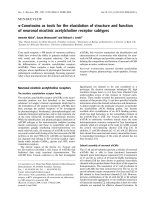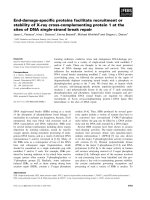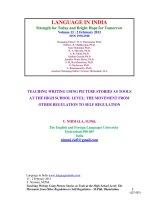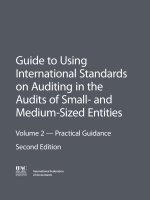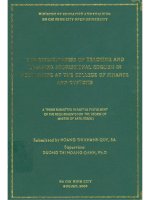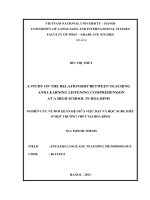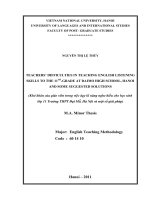TEACHING WRITING USING PICTURE STORIES AS TOOLS AT THE HIGH SCHOOL LEVEL: THE MOVEMENT FROM OTHER REGULATION TO SELF REGULATION doc
Bạn đang xem bản rút gọn của tài liệu. Xem và tải ngay bản đầy đủ của tài liệu tại đây (2.37 MB, 261 trang )
Language in India www.languageinindia.com
13 : 2 February 2013
Y. Nirmala, M.Phil.
Teaching Writing Using Picture Stories as Tools at the High School Level: The
Movement from Other Regulation to Self-Regulation – M.Phil. Dissertation 1
LANGUAGE IN INDIA
Strength for Today and Bright Hope for Tomorrow
Volume 13 : 2 February 2013
ISSN 1930-2940
Managing Editor: M. S. Thirumalai, Ph.D.
Editors: B. Mallikarjun, Ph.D.
Sam Mohanlal, Ph.D.
B. A. Sharada, Ph.D.
A. R. Fatihi, Ph.D.
Lakhan Gusain, Ph.D.
Jennifer Marie Bayer, Ph.D.
S. M. Ravichandran, Ph.D.
G. Baskaran, Ph.D.
L. Ramamoorthy, Ph.D.
Assistant Managing Editor: Swarna Thirumalai, M.A.
TEACHING WRITING USING PICTURE STORIES AS TOOLS
AT THE HIGH SCHOOL LEVEL: THE MOVEMENT FROM
OTHER REGULATION TO SELF REGULATION
Y. NIRMALA, M.Phil.
The English and Foreign Languages University
Hyderabad-500 605
India
<327-587>
Language in India www.languageinindia.com
13 : 2 February 2013
Y. Nirmala, M.Phil.
Teaching Writing Using Picture Stories as Tools at the High School Level: The
Movement from Other Regulation to Self-Regulation – M.Phil. Dissertation 2
TEACHING WRITING USING PICTURE STORIES AS TOOLS
AT THE HIGH SCHOOL LEVEL: THE MOVEMENT FROM
OTHER REGULATION TO SELF REGULATION
Y. NIRMALA
Supervisor
Dr. CHANCHALA K. NAIK
Professor and Head,
Center for ESL Studies
EFLU, Hyderabad
A thesis submitted in partial fulfillment of the requirements for the
Degree of
MASTER OF PHILOSOPHY IN ENGLISH
[English Language Teaching]
THE ENGLISH AND FOREIGN LANGUAGES UNIVERSITY
HYDERABAD-500 605
August 2008
<327-587>
Language in India www.languageinindia.com
13 : 2 February 2013
Y. Nirmala, M.Phil.
Teaching Writing Using Picture Stories as Tools at the High School Level: The
Movement from Other Regulation to Self-Regulation – M.Phil. Dissertation 3
Dedicated to:
Amma, Nana and Chinni
<327-587>
Language in India www.languageinindia.com
13 : 2 February 2013
Y. Nirmala, M.Phil.
Teaching Writing Using Picture Stories as Tools at the High School Level: The
Movement from Other Regulation to Self-Regulation – M.Phil. Dissertation 4
AKNOWLEDGEMENTS
I would like to thank:
My supervisor, Dr. C. K. Naik for her able guidance, patience and approachable
nature without which this work of mine would not have been possible. Thank You
madam for all that, you have been to me.
Amma, for your everlasting love, affection, continuous support, encouragement
and regular phone calls. Nana, for all YOU are. Chinni for your unflinching love
and care.
My Ammamma and other family members for all their blessings, love, care and
affection.
Members of the RSC (ELE), for academic support.
Prof. A. V. Ashok for his affection and blessings.
Dr. Shruti Sircar for all her help and encouragement during the initial stages of
the study.
Dr. Padmini Shankar for her support, encouragement, and dinners.
Prof. Raja Gopal, Prof. Paul Gunashekar, Prof. Mohan Raj
Dr.Mukta Prahalad, Prof. Prema Kumari, Dr. Geetha Durairajan,
<327-587>
Language in India www.languageinindia.com
13 : 2 February 2013
Y. Nirmala, M.Phil.
Teaching Writing Using Picture Stories as Tools at the High School Level: The
Movement from Other Regulation to Self-Regulation – M.Phil. Dissertation 5
Ms.Lina Mukhopadhyaya, Dr. Kishore Kumar, Dr.Anand Mahanand, Dr. Veda
Sharan, Dr. Meera Srinivas, Dr.Julu Sen, for being wonderful teachers.
Mrs.Bharathy and Mrs. Pauline for all their love, support and affection.
Mrs. Amitha Ruth, for her love, affection and encouragement always.
Sr. Shiny K.P (JMJ), for being a wonderful friend. Thanks for your prayers, support,
and phone calls.
Anitha, my dear friend for all her love, help, support, encouragement and prayers.
Folk thanks for your lonnnggggg…. phone calls, chatter under trees, fun, food and
all that you have been to me.
Sowji, my heartfelt friend for all the emotional support, massages, food, fun,
prayers, long chats, typing and continuous encouragement. Dolon, for all the
chatter, fun, massages, academic and emotional support always.
My friends, Tesfayer (professor), Tadesse (Teddy), Madhav (Folk), Meena,
Asebu, Manisha, Vishwa Prasad, for all your support.
Ram, Reddy, Padma, for the great friends you are. Thanks for your phone calls,
help and encouragement.
Mr. Venkat and Sowji for your care, affection, support and phone calls.
Jagadeesh anna for all your help always.
Joe & Alice, Aru and Reju, Sweta and Depak, Bhavani and Cherry, Seshu,
Shivaram, Samuel, Lidwin, Robert, Richard, Abhilash, Aravind, Sudarshan,
<327-587>
Language in India www.languageinindia.com
13 : 2 February 2013
Y. Nirmala, M.Phil.
Teaching Writing Using Picture Stories as Tools at the High School Level: The
Movement from Other Regulation to Self-Regulation – M.Phil. Dissertation 6
Kavitha, Sheela, Ganga, Aruna, Zakia, Wafaa, Santana Lakshmi, Sr. Sharada,
Maruti, Joshna, Suchi, Sree, Poori, Rani, Manju Latha, Reena, Ritu, Sumathi,
Sheik for being good friends.
Ravi, Vamsi and Praveen for your help.
Raja (J. J), for your ever-ending help, affection, support at every stage of this
study. Thanks ra for typing, proof reading, biblio, print outs, formatting. Without YOU
this work would have been impossible. Hats off for the patience and hard work that you
sacrificed for me.
Sr. Marie Claire, for all your love and prayers.
The CIEFL library staff for their help.
The Government Boys High School, Kuppam Staff and Students for all their
contribution, help and time for this study. Thanks for the Students of Class IX, for
their patience and cooperation during data collection.
Sagar bhaiya and Sai Xerox, Without YOU my stay on the campus would not be
happy.
Members of DBMSA for your direct and indirect support.
Last but not the least, I must put on record my thanks and indebtedness to all
those who have helped me in some way or the other in the completion of my
research work.
<327-587>
Language in India www.languageinindia.com
13 : 2 February 2013
Y. Nirmala, M.Phil.
Teaching Writing Using Picture Stories as Tools at the High School Level: The
Movement from Other Regulation to Self-Regulation – M.Phil. Dissertation 7
Table of Contents
Chapter One: Introduction
1.0 Statement of the Problem
1.1 Importance of English in the Global Context
1.2 Importance and Status of English in India
1.3 The ELT Situation in Rural India
1.4 Background
1.5 Hypothesis/ Assumptions of the Study
1.6 The Research Problem
1.7 Relevance of the Study
1.8 Scope of the Study
1.9 Chapterization
1.10 Overview of the Chapter
Chapter Two: Writing as a Skill and its Various Aspects
2.0 Introduction
2.1 Writing
2.2 Defining Writing
2.3 The Importance of Writing
<327-587>
Language in India www.languageinindia.com
13 : 2 February 2013
Y. Nirmala, M.Phil.
Teaching Writing Using Picture Stories as Tools at the High School Level: The
Movement from Other Regulation to Self-Regulation – M.Phil. Dissertation 8
2.4 Writing as a Complex Skill
2.4.1 Characteristics of Writing
2.5 Approaches to Teaching Writing – an Overview
2.5.1 The Control - to - Free Approach
2.5.2 The Free Writing Approach
2.5.3 The Paragraph Pattern Approach
2.5.4 The Grammar – Syntax – Organization Approach
2.5.5 The Communicative Approach
2.5.6 The Product Approach
2.5.7 The Process Approach
2.6 Kinds of Writing
2.7 Forms of Writing
2.7.1 Summary Writing
2.7.2 Essay Writing
2.7.3 Paragraph Writing
2.7.4 Journal Writing
2.7.5 Poetry Writing
2.7.6 Letter Writing
2.7.7 Story Writing
2.7.8 Picture Writing
2.7.9 The Use of Pictures in the ESL Classroom
<327-587>
Language in India www.languageinindia.com
13 : 2 February 2013
Y. Nirmala, M.Phil.
Teaching Writing Using Picture Stories as Tools at the High School Level: The
Movement from Other Regulation to Self-Regulation – M.Phil. Dissertation 9
2.8 Conclusion
Chapter Three: Theoretical Framework
3.0 Introduction
3.1 Review of Related Literature
3.2 Implications for the Present Study
3.3 Theoretical Underpinnings of the Study
3.3.1 Some Perspectives
3.3.2 Problems of ESL Learners
3.3.3 Teaching Writing – A Movement from Other Regulation
to Self-Regulation
3.3.4 Discussion
3.4 Conclusion
Chapter Four: Research Design
4.0 Introduction
4.1 The Research Design
4.2 The Pictures
4.3 The Subjects
<327-587>
Language in India www.languageinindia.com
13 : 2 February 2013
Y. Nirmala, M.Phil.
Teaching Writing Using Picture Stories as Tools at the High School Level: The
Movement from Other Regulation to Self-Regulation – M.Phil. Dissertation 10
4.3.1 The Learners’ Profile
4.3.2 Attitude to Learning English
4.4 The Teachers
4.4.1 Teachers’ Profile
4.4.2 Attitude to Teaching English
4.5 Location and Environment of the School
4.6 Classroom Observation
4.7 Techniques Used in the Teaching - Learning Process
4.8 Curriculum and Syllabus
4.9 Research Procedure
4.10 Conclusion
Chapter Five: Data Analysis and Interpretation
5.0 Introduction
5.1 Procedure for Data Analysis
5.2 Questionnaire
5.3 Analysis of Classroom Teaching Tasks
5.4 Analysis of the Answer Scripts of the Recently Conducted Examinations
5.5 Discussion of the Course Book
5.5.1Writing
5.5.2 Analysis
<327-587>
Language in India www.languageinindia.com
13 : 2 February 2013
Y. Nirmala, M.Phil.
Teaching Writing Using Picture Stories as Tools at the High School Level: The
Movement from Other Regulation to Self-Regulation – M.Phil. Dissertation 11
5.6 Gap between the Expected Level and the Present Level
5.7 Discussion on the English Question Papers
5.8 Teaching /Learning Methods
5.9 Poor Proficiency in Skills in General and Writing in Particular
5.10 Reasons for Poor Performance of the Learners
5.10.1 Lack of Interest
5.10.2 Lack of Exposure
5.11 Informal Interviews with Teachers
5.12 Informal Interviews with Learners
5.13 Pre-test (L 2 test and L 1 test)
5.13.1 The L2 Task (Pre- test)
5.13.2 Task Demands
5.13.3 The Pre-test L2 Task: Discussion and Analysis
5.13.3.1 Grammar
5.13.3.2 Vocabulary
5.13.3.3 Organization
5.13.3.4 L1 Influence
5.14 L1 Test (Pre – test)
5.14.1 The L1 Task
5.14.2 Task Demands
5.14.3 L1 Task: Discussion and Analysis
5.15 Procedure Used for Teaching Writing: the Three Phases
<327-587>
Language in India www.languageinindia.com
13 : 2 February 2013
Y. Nirmala, M.Phil.
Teaching Writing Using Picture Stories as Tools at the High School Level: The
Movement from Other Regulation to Self-Regulation – M.Phil. Dissertation 12
5.16 Feedback
5.17 The Improvement Task
5.17.1 The Task
5.17.2 Task Demands
5.17.3 Task Discussion and Analysis
5.17.4 Grammar
5.17.5 Vocabulary
5.17.6 Organization
5.17.7 L1 Influence
5.18 End Test
5.18.1 The Task
5.18.2 Task Demands
5.18.3 End Test: Discussion and Analysis
5.18.4 Grammar
5.18.5 Vocabulary
5.18.6 Organization
5.18.7 L1 Influence
5.19 Comparison between the Pre test and the Post test
5.20 Discussion
5.21 Conclusion
Chapter Six: Conclusion
<327-587>
Language in India www.languageinindia.com
13 : 2 February 2013
Y. Nirmala, M.Phil.
Teaching Writing Using Picture Stories as Tools at the High School Level: The
Movement from Other Regulation to Self-Regulation – M.Phil. Dissertation 13
6.0 Introduction
6.1 Overview of the Study
6.2 Findings of the Study
6.2.1 Learners’ Proficiency
6.2.2 Learning Environment
6.2.3 Family Background
6.2.4 Teacher’s Attitude
6.3 Implication of the Findings
6.3.1 Implication for the Learners
6.3.2 Implication for the Teachers
6.3.3 Implication for the Parents
6.3.4 Implication for the Institution
6.4 Recommendations for Pedagogical Action
6.4.1 Pedagogical Measures
6.4.2 Remedial Measures
6.4.3 Motivational Measures
6.5 Limitations of the Study
6.6 Suggestions for Further Research
6.7 Conclusion
<327-587>
Language in India www.languageinindia.com
13 : 2 February 2013
Y. Nirmala, M.Phil.
Teaching Writing Using Picture Stories as Tools at the High School Level: The
Movement from Other Regulation to Self-Regulation – M.Phil. Dissertation 14
Bibliography
Appendix
Appendix-1
Questionnaire
Sample Pretest Scripts
Sample Improvement Task Scripts
Posttest Sample Scripts
Appendix-2
Sample Picture Stories
Sample Picture Cards
Sample Reading Cards
List of Figures
Chapter Two
Figure: 1 Producing a Piece of Writing
Chapter Three
Figure 1: The Relationship between Writing and Thinking
Figure 2: The Dimensions of the Study
<327-587>
Language in India www.languageinindia.com
13 : 2 February 2013
Y. Nirmala, M.Phil.
Teaching Writing Using Picture Stories as Tools at the High School Level: The
Movement from Other Regulation to Self-Regulation – M.Phil. Dissertation 15
Chapter Four
Figure: 1 Research Procedure
List of Tables
Chapter Two
Table: 1 Characteristics of Writing
Table: 2 Characteristics of Scholarly Writing
Chapter Four
Table: 1 Classroom Constitution: Section ‘C’
Table: 2 Teachers’ Profile
<327-587>
Language in India www.languageinindia.com
13 : 2 February 2013
Y. Nirmala, M.Phil.
Teaching Writing Using Picture Stories as Tools at the High School Level: The
Movement from Other Regulation to Self-Regulation – M.Phil. Dissertation 16
CHAPTER ONE
INTRODUCTION
1.0 Statement of the Problem
The purpose of this study is to help ESL learners at the High School level in
regional medium schools of Andhra Pradesh to improve their writing skill in English
through strategic use of picture stories. The poor proficiency level of these learners in
English in general and in writing skill in particular poses a serious problem for their
educational advancement, career choices and employment opportunities. Given the
importance of English in the contemporary world, proficiency in English has become
almost a prerequisite for a successful career. But, what has been noticed in rural Andhra
Pradesh both at the school and college level, where the medium of instruction is mother
tongue (L1), is that the basic standard of learners in English is not upto the expected
level. On an average, their achievement level is a matter of concern, more so in terms of
writing skill. The present study , therefore, is an attempt at assessing the learners’ ESL
writing skill at the class IX level and then to apply picture story writing as an innovative
teaching strategy to find out if there is expected improvement in their writing
performance or otherwise. The decision to use picture story writing as a tool is a
deliberate choice because there has been sufficient argument that ESL teachers of writing
can find a valuable resource in pictures to improve the learners’ writing skill (L.A. Hill:
<327-587>
Language in India www.languageinindia.com
13 : 2 February 2013
Y. Nirmala, M.Phil.
Teaching Writing Using Picture Stories as Tools at the High School Level: The
Movement from Other Regulation to Self-Regulation – M.Phil. Dissertation 17
1982; Andrew Wright: 1989; Melinda Y. Small, Suzanne B. Lovett, and Martha S.Scher:
1993).
This chapter begins by discussing the importance of English in global context,
followed by the importance and status of English in India. The ELT situation at the
school level in rural India is briefly discussed. This chapter also contains the research
hypothesis, the assumptions on which the study is based, the significance and scope of
the study. Finally, a brief outline of the dissertation is also presented in the form of
chapterization.
1.1 Importance of English in the Global Context
According to David Crystal, English is the language ‘on which the sun never sets’
(1997: 67). The demographic spread of English is indeed phenomenal today as English is
being used in most of the countries in the world. It is performing a variety of functions in
different parts of the world ranging from mother tongue to link language. The fields of
science and technology, industry and commerce, travel, entertainment and globalization
in different walks of human life have accelerated the spread and use of English. If the
twenty first century is dominated by technology, it is equally dominated by the English
language. “The numbers of South Asian users of English now exceed the combined
population of the inner Circle of English – the United States, the United Kingdom,
Canada, Australia and New Zealand. The Asian continent, particularly South Asia and
<327-587>
Language in India www.languageinindia.com
13 : 2 February 2013
Y. Nirmala, M.Phil.
Teaching Writing Using Picture Stories as Tools at the High School Level: The
Movement from Other Regulation to Self-Regulation – M.Phil. Dissertation 18
China, have altered the international profile of world Englishes” (Kachru et al 2008: 7).
The people all over the world have come to depend on English for their economic and
social well-being. Accordingly, English Language Teaching and Learning has got more
attention than any other language learning. In this regard, Kachru mentions:
Just a few centuries ago, English was spoken by just five to seven million
people on one, relatively small island, and the language consisted of
dialects spoken by monolinguals. Today there are more non-native users
of English, and English has become the linguistic key used for opening
borders: it is a global medium with local identities and messages (1996:
11).
The most important reason for the success of English, according to Kachru is
naturally the historical role of England as a colonial power. He also lists some other
reasons for the dominance of English around the world:
it’s propensity for acquiring new identities, it’s power of assimilation, it’s
adaptability to “decolonization” as a language, and it’s provision of a
flexible medium for literary and other types of creativity across languages
and cultures (1987:122).
In the contemporary computer age, English is a passport for better career. It plays
a very significant role in international domains such as politics, media and
communication, education, business, advertising, broadcasting, motion pictures and
transport. It is the dominant world language of science and technology. No otherworld
language – Spanish, Chinese, French, Russian can be compared to the position occupied
by English as an international language.
<327-587>
Language in India www.languageinindia.com
13 : 2 February 2013
Y. Nirmala, M.Phil.
Teaching Writing Using Picture Stories as Tools at the High School Level: The
Movement from Other Regulation to Self-Regulation – M.Phil. Dissertation 19
English is important because it has become the ‘linguistic tool’ permeating into
every walk of human life. People all over the world depend on English for their well-
being. English is learnt everywhere because people have found out that it is the entry card
for better career, better pay package, advanced knowledge and for communication with
the entire world.
With the growing impact of globalization and privatization, English has become
a window to the world, as it is creating more and more opportunities in every field of life.
English is the global lingua franca as it is connecting different people from all over the
world, different cultures, languages and political and economic issues in our day-to-day
lives.
In this age of information and technology, as we are constantly bombarded by
information, English as the major medium gives access to update information. It is
playing a ‘working role’ in all parts of the world, as its necessity is being felt by all
people in their lives. Therefore, there is a massive burgeoning in the number of people
learning English. According to Graddol (2006), the number of people learning English is
likely to reach a peak of around two billion in the next 10-15 years. As the internet is
growing explosively, English is instrumental in keeping us on par with it. It is emerging
as a first rank language as it has affected all aspects of human society
<327-587>
Language in India www.languageinindia.com
13 : 2 February 2013
Y. Nirmala, M.Phil.
Teaching Writing Using Picture Stories as Tools at the High School Level: The
Movement from Other Regulation to Self-Regulation – M.Phil. Dissertation 20
1.2 Importance and Status of English in India
Keeping in view the worldwide recognition being given to English, the Indian
Government has been formulating various policies to promote the use and spread of
English. Though Hindi is the national language of India, English remains as a national
lingua franca to a greater degree.
India has had a longer exposure to English than any other country in the world.
English has a definite place in the curriculum of Indian schools, colleges and universities.
In fact, the teaching of English in India as a second / third language has been accepted
widely. English serves as a linguistic tool for administrative cohesiveness in the country,
causing people who speak different languages to become united and thus it serves as a
language of wider communication. The English language is a tie that helps to bind the
many segments of the society together. It is also a linguistic bridge between the major
countries of the world and India.
English has a special national status in India, because it has a place in the
parliament, judiciary, broadcasting, journalism and in the education system. In the field
of education, English functions as a language for dissemination of knowledge.
Information in every field, be it humanities, science, commerce or technology, is readily
<327-587>
Language in India www.languageinindia.com
13 : 2 February 2013
Y. Nirmala, M.Phil.
Teaching Writing Using Picture Stories as Tools at the High School Level: The
Movement from Other Regulation to Self-Regulation – M.Phil. Dissertation 21
available in English. Therefore, English language learning has become necessary for all
Indian rural learners.
The importance of speaking and writing in English has recently increased
significantly because English has become popular for business, commerce and cultural
transaction and especially for internet communications throughout the world. With the
growing technology and outsourcing, proficiency in English has indeed become the
essential criterion for acquiring a job. The prevailing view in India seems to be that
unless students learn English, they can only work in limited job sectors. Those who do
not have basic knowledge of English cannot obtain good fetching jobs. Men and women,
who cannot comprehend and interpret English, are unemployed even if they are well
educated. It cannot be denied the fact that for those who realize that learning English is
the necessity have plenty of job opportunities today.
Considering all these factors, ELT in India is becoming a thriving and lucrative
business where private expensive English medium schools exist side by side with almost
free regional medium schools maintained by the Government or local bodies. If the
British taught English for administrative convenience to a minority, ELT is taught today
in India as the language for social and economic upliftment towards global
modernization. Ironically, though Hindi is the national language there are more English
schools than Hindi medium schools. The English medium schools may opt for the
<327-587>
Language in India www.languageinindia.com
13 : 2 February 2013
Y. Nirmala, M.Phil.
Teaching Writing Using Picture Stories as Tools at the High School Level: The
Movement from Other Regulation to Self-Regulation – M.Phil. Dissertation 22
regional language as the second language in place of Hindi but in the Hindi medium
schools, English is at least taught as a subject.
So, the relevance of ELT to the Indian educational scenario cannot be ignored.
Since English is the most important language for education, many schools and
institutions have developed various ELT programmes with many new institutions of ELT
cropping up every year. With its importance being realized, research in ELT is
expanding. ELT has thus become a powerful tool that can lead the country towards a
highly developed state.
The Indian society is developing multi-dimensionally; so it is important for every
Indian to have some proficiency in English. The impact of English is not only continuing
but also increasing, because in the English speaking world, India has a unique position. A
decade ago, the United States of America was the country with the largest English
speaking population. Today, India has over taken it. Therefore, definitely, a change will
be remarkable in the future. Thus, a positive attitude to English as a national language is
essential for the Indian society.
Due to this quantum increase in the number of schools and colleges and the
enrollment of students, the number of students learning English has increased multifold.
This has resulted in the problem of having incompetent teachers of English, which lowers
the standard of learners.
<327-587>
Language in India www.languageinindia.com
13 : 2 February 2013
Y. Nirmala, M.Phil.
Teaching Writing Using Picture Stories as Tools at the High School Level: The
Movement from Other Regulation to Self-Regulation – M.Phil. Dissertation 23
1.3 The ELT Situation in Rural India
English has been introduced as a compulsory second language from primary level
onwards for students of regional medium schools, which has contributed to Bilingual
education.
English medium education being costly is not within the reach of the most of the
learners studying in Government schools in rural India and as a result, only the private
educational institutions offer English medium education. So, learners from the lower
strata of the society are forced to go to Government schools, where regional medium
education with English as a second or third language is the only option.
Learners who come from regional medium schools lack required exposure to
English language. These learners do not have a motivating and supporting environment
to learn English. For these learners, the only opportunity to learn English is the classroom
atmosphere. Various other factors such as poor economic background, illiterate parents,
lack of resources, etc. contribute to the learners’ poor ESL environment in rural areas.
With the various policies of the government, the situation seems improving, but
still a lot has to be done to facilitate the English learning environment in the regional
<327-587>
Language in India www.languageinindia.com
13 : 2 February 2013
Y. Nirmala, M.Phil.
Teaching Writing Using Picture Stories as Tools at the High School Level: The
Movement from Other Regulation to Self-Regulation – M.Phil. Dissertation 24
medium schools of India. In order to become proficient in English, the four language
skills (LSRW) are very important, so adequate help and guidance is inevitable to improve
the language skills of learners of English as a second language.
1.4 Background
Teaching language as an activity is important especially where learners lack the
expected writing proficiency. In Andhra Pradesh, it has been observed that many ESL
learners at class IX level, especially those from regional medium schools do not have the
required writing proficiency. This could be because of several factors such as inadequate
writing practice in the classroom, poor vocabulary, examination oriented writing, teacher-
dictated writing, lack of exposure to English, lack of a homogenous English speaking
community, limited reading habits and so on.
In spite of learning English for about four to five years and still being unable to
write a paragraph correctly and coherently calls for an investigation. It has been noticed
that a large percentage of failures from regional medium schools in class X public
examination occurs especially due to poor performance in English.
Though English is the second language for these learners, they do not get enough
help to improve their proficiency in English. It is not surprising to see English lessons are
<327-587>
Language in India www.languageinindia.com
13 : 2 February 2013
Y. Nirmala, M.Phil.
Teaching Writing Using Picture Stories as Tools at the High School Level: The
Movement from Other Regulation to Self-Regulation – M.Phil. Dissertation 25
being taught in Telugu. In addition to this, learning English is rote-based and does not
focus on real knowledge of the language. It was understood by informal chats with the
students that they think English is the most difficult subject than other subjects like
mathematics and science.
Poor proficiency in English does not only affect the performance and grades of
these learners in class X public examination, but also affects their career and further
education. After class X, learners are in confusion and under a dilemma about making
plans for higher education as they lack proficiency in English. Sometimes they are forced
to opt for vocational courses like ITI, Polytechnic etc, which lowers the self-esteem and
confidence levels of these learners. Therefore, there is an extreme need to help these
learners improve their academic writing skill in English language.
1.5 Hypothesis/ Assumptions of the Study
The following are the hypothesis and assumptions of the study:
There would be basic problems with writing.
<327-587>
